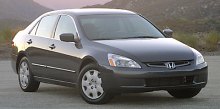American
Accord
 USA
is definitely the most important market for Honda Accord, even
eclipsing
the domestic market. For more than a decade, Accord has been either no.
1 or no. 2 seller in America sales chart, together with arch-rival
Toyota
Camry. Enjoying a sales of more than 400,000 units a year there, Honda
can afford to build an Accord differing from the Japanese / European
version
to suit the American taste. USA
is definitely the most important market for Honda Accord, even
eclipsing
the domestic market. For more than a decade, Accord has been either no.
1 or no. 2 seller in America sales chart, together with arch-rival
Toyota
Camry. Enjoying a sales of more than 400,000 units a year there, Honda
can afford to build an Accord differing from the Japanese / European
version
to suit the American taste.
The
most obvious difference between American taste an others is size -
American
always ask for big cars and big engines. As you can see from the
specifications
table below, American Accord is one size larger than Japanese /
European
Accord. To save your time, here gives you the picture: it is 15cm
longer,
6cm wider and the wheelbase is 7cm longer. The American Accord also get
bigger engines - 2.4-litre four-cylinder and 3.0-litre V6, the latter
is
not available elsewhere. Choosing the V6 and you end up at 1560kg,
150kg
heavier than the top Japanese Accord.
However,
compare with the previous generation American Accord, the new one
gained
just a little width and height while overall size remains largely
unchanged.
Interior space was not altered as well, but this is still a large and
comfortable
cabin by any standard.
 The
next American taste influencing the Accord is the preference of comfort
over driver appeal. Although the basic suspensions share with other
Accords,
the choice of springs, dampers and anti-roll bars bias towards the soft
side. No wonder it rides smoothly but rolls and pitches in corner more
than keen drivers like. It also understeers early and feels a bit nose
heavy for the V6 version. Steering feel is again muted. Grip level is
unremarkable.
Some road testers talk about improvement of driver appeal, such as
heavier
and more accurate steering, improved power, tidier body control etc.,
but
after waiting for 5 years we expect much more improvement than that.
There
are too many rivals now eclipse the Accord for driver appeal, such as
Volkswagen
Passat and Nissan Altima, while Mazda 6 is another league higher. Even
Toyota Camry now matches the Accord, what a shame to a car once praised
for fun to drive. The
next American taste influencing the Accord is the preference of comfort
over driver appeal. Although the basic suspensions share with other
Accords,
the choice of springs, dampers and anti-roll bars bias towards the soft
side. No wonder it rides smoothly but rolls and pitches in corner more
than keen drivers like. It also understeers early and feels a bit nose
heavy for the V6 version. Steering feel is again muted. Grip level is
unremarkable.
Some road testers talk about improvement of driver appeal, such as
heavier
and more accurate steering, improved power, tidier body control etc.,
but
after waiting for 5 years we expect much more improvement than that.
There
are too many rivals now eclipse the Accord for driver appeal, such as
Volkswagen
Passat and Nissan Altima, while Mazda 6 is another league higher. Even
Toyota Camry now matches the Accord, what a shame to a car once praised
for fun to drive.
 Space
and ride comfort aside, the American Accord seems unable to match the
Japanese
version in many ways. Its exterior design has been criticized by many
journalists
and can only be described as "dull". Its drag coefficient, at 0.30, is
much worse than Japanese Accord’s 0.26. Its 2.4-litre i-VTEC engine
generates
30 less horsepower than the Japanese equivalent. Space
and ride comfort aside, the American Accord seems unable to match the
Japanese
version in many ways. Its exterior design has been criticized by many
journalists
and can only be described as "dull". Its drag coefficient, at 0.30, is
much worse than Japanese Accord’s 0.26. Its 2.4-litre i-VTEC engine
generates
30 less horsepower than the Japanese equivalent.
The
3.0 V6 evolves from the previous generation. Still employs a VTEC head
instead of the more sophisticated i-VTEC of the four-cylinder engine,
and
still a sohc design, it is amazing that Honda can push maximum power to
240hp, 40 more than before. This is done by merely smoothing intake and
exhaust breathing and using larger valves. It can propel the car from
rest
to 60mph in 7 seconds flat, very quick for a family car. Both V6 and
the
balance-shaft-incorporated four-cylinder are smooth and refined.
The
highlight of American Accord is still the way it rides and travels with
minimum noise and vibration. The smooth-shifting new 5-speed automatic
is another good point, just like the refined power plant. These are
most
buyers concern, but are they enough to distinguish the new Accord from
competitors? this year’s sales figure will tell, but it already lost
support
from the car enthusiasts here in AutoZine.
|